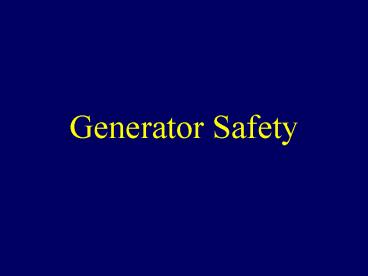Generator Safety - PowerPoint PPT Presentation
1 / 16
Title:
Generator Safety
Description:
Generator Safety. Portable gas generators convert mechanical energy ... 5 construction deaths due to electrical shock from portable generators between 1991-2004 ... – PowerPoint PPT presentation
Number of Views:4320
Avg rating:5.0/5.0
Title: Generator Safety
1
Generator Safety
2
- Portable gas generators convert mechanical energy
into electrical energy - The mechanical energy is provided through the
means of an internal combustion engine
3
Potential Hazards
- Carbon monoxide poisoning
- Electrocution
- Fire / explosion
- Noise pollution / distraction
4
Safety Statistics
- 5 documented construction related deaths from
carbon monoxide poisoning between 1991-2004 - 5 construction deaths due to electrical shock
from portable generators between 1991-2004 - 2 construction industry deaths between 1991-2004
due in part to noise pollution caused by portable
generators
5
Related Accidents
- Several accidents and deaths have occurred where
generators have been used in confined spaces
resulting in the build-up of poisonous carbon
monoxide gas. The Consumer Product Safety
Commission reports that between 1999 and 2004
portable generators caused 172 CO poisoning
deaths in the U.S.
6
- The risk from electrical shock due to improperly
grounded receptacles and use in wet conditions
has led to several accidents and deaths
7
OSHA Regulations
- 1926.404(b)(1)(ii)
- Receptacles on a two-wire, single-phase portable
or vehicle-mounted generator rated not more than
5 kW, where the circuit conductors of the
generator are insulated from the generator frame
and all other grounded surfaces, need not be
protected with ground-fault circuit interrupters.
(Otherwise GFCI is required)
8
OSHA continued
- 1926.404(f)(3)
- (i) Portable generators under the following
conditions, the frame of a portable generator
need not be grounded and may serve as the
grounding electrode for a system supplied by the
generator - (A) The generator supplies only equipment mounted
on the generator and/or cord- and plug-connected
equipment through receptacles mounted on the
generator, and - (B) The non-current carrying metal parts of
equipment and the equipment grounding conductor
terminals of the receptacles are bonded to the
generator frame
9
Safety Procedures
10
Carbon Monoxide Protection
- Carbon monoxide is produced by engine combustion.
It is odorless and causes suffocation by
depriving the body of oxygen. - Generators should never be used in confined
spaces nor near doors, windows, or vents. - Generators should only be used Outdoors.
- If you get dizzy or feel sick while using a
generator, get to fresh air immediately - do not delay
11
Electrical Shock Prevention
- Appliances should be connected to generators
using heavy-duty extension cords designed for
outdoor use. The cords should be three-pronged. - Make sure cords are rated for higher wattages
than the total of all appliances connected to it. - Generators should also be placed so that attached
cords are kept away from high traffic areas and
do not present a tripping hazard.
12
Electrical Shock Prevention
- Some generators come with onboard ground fault
circuit interrupters. It is good practice to use
plug-in GFCIs on units that do not have them
onboard. OSHA requires the use of GFCIs on
generators above 5 kW.
13
Electrical Shock Prevention
- Generators should not be used in wet conditions
if at all possible. - Protect the generator from moisture but be aware
of carbon monoxide risks while doing so. - Always dry hands before touching a generator if
they are wet.
14
Fire Prevention
- Fuel for generators should be stored away from
living areas in properly labeled, non-glass
safety containers. - Generators should be shut down and allowed to
cool off before refueling to prevent ignition of
fuel or vapors.
15
Noise Precautions
- Generators should be placed as far from work
operations as possible to limit noise pollution - Excessive noise can cause distractions that lead
to unsafe work practices - If noise cannot alleviated and is above safe
levels, proper hearing protection should be worn
16
Additional Information
- http//www.dom.com/about/safety/generator.jsp
- http//www.usfa.dhs.gov/citizens/all_citizens/co/g
enerator.shtm - http//www.generatorsafety.org/































